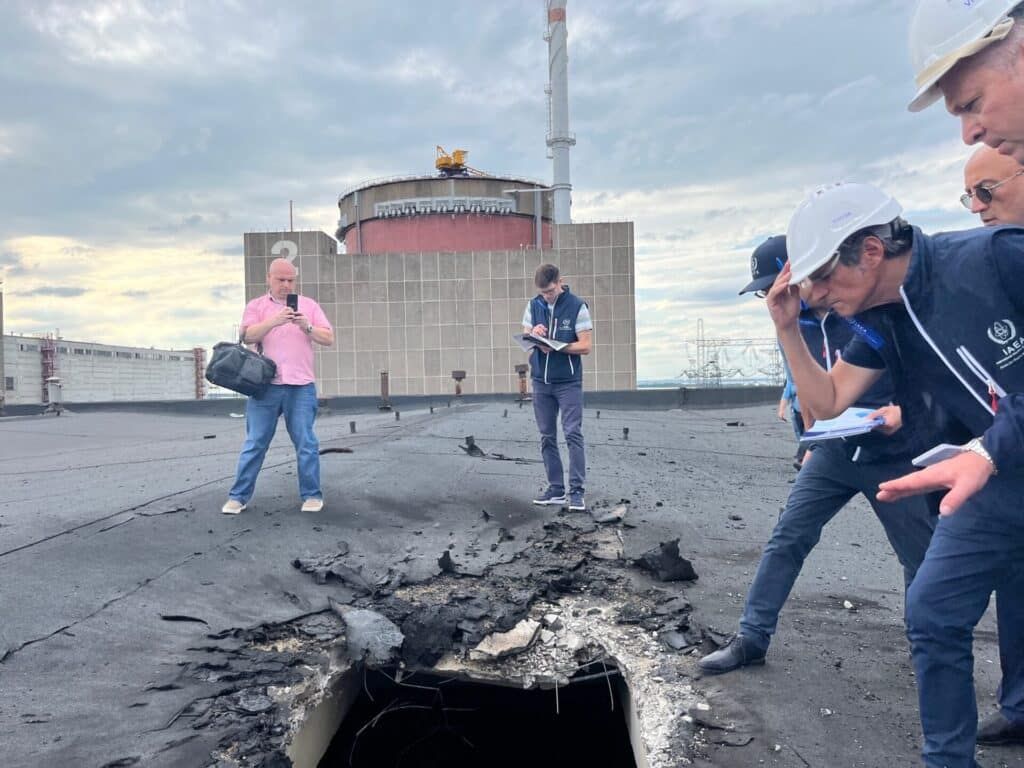Why a new convention to protect nuclear installations in war is a bad idea
By Michal Onderco, Clara Egger | December 5, 2022
 IAEA Director General Rafael Mariano Grossi and members of the International Atomic Energy Agency (IAEA) delegation inspect the impacts of a rocket shell during a visit to the Zaporizhzhia nuclear power plant in Ukraine on September 1, 2022. (Photo Fredrik Dahl / IAEA)
IAEA Director General Rafael Mariano Grossi and members of the International Atomic Energy Agency (IAEA) delegation inspect the impacts of a rocket shell during a visit to the Zaporizhzhia nuclear power plant in Ukraine on September 1, 2022. (Photo Fredrik Dahl / IAEA)
In recent weeks, several voices have called for adopting new legal instruments to protect civilian installations from military attacks during conflicts. The prime motivation stems from Russia’s shelling and occupation of the Zaporizhzhia nuclear power plant—Europe’s largest—as part of its ongoing war against Ukraine. This event, combined with Russia’s repeated transgression of international laws of armed conflicts, is said to reveal the weaknesses and inadequacy of existing legal protections. Such arguments were also aired during the 2020 NPT Review Conference held this summer in New York (after a two-year delay due to the global COVID-19 pandemic) as well as, more recently, in the columns of the Bulletin of the Atomic Scientists. Proponents of improved legal protections argue that a new convention is needed because of the ambiguity of existing international laws and the lack of enforcement mechanisms.
Although concerns about the protection of nuclear sites in war settings are wholly justified, the cure proposed might be worse than the disease. First, calls for a new regime reflect a partial reading of the legal and political mechanisms surrounding the protection of nuclear installations during a conflict. Second, because international law and political commitments already protect against attacks on nuclear installations, a new convention could add undesirable complexity with countries picking and choosing their commitments, which ultimately would weaken existing protections. Calls for new legal instruments would also send counterproductive signals in a context where the value of international norms is already challenged at the domestic and global levels.
There are no gaps. Legally, international humanitarian law norms already establish a detailed and unambiguous system of protection to avoid nuclear facilities becoming battlefields or being targeted by military attacks. The obligations of warring parties derive from two sources: They are linked to the general protection applicable to all types of civilian infrastructure in wartime but are reinforced and by specific protections applicable to nuclear power plants.
By default, nuclear facilities are considered civilian infrastructures even if doubts exist about their use, according to the Additional Protocol I to the Geneva Conventions (1977) as well as in contact areas (when military forces or combat operations are in the vicinity of power plants). This consideration is confirmed in the official commentary on the Additional Protocol I published by the International Committee of the Red Cross in 1987. Nuclear facilities are therefore already protected against attacks and reprisals.
One could argue that Russia withdrew from the Additional Protocol I in 2019. At the time, Russia argued that the International Humanitarian Fact-Finding Commission—established by the protocol to investigate breaches to the international humanitarian law—could be biased, as it did not include a Russian representative. But because of the unique nature and scale of the risks associated with nuclear facilities, other international norms apply, too. Warring parties have an obligation to refrain from locating military objectives at or in the vicinity of such facilities. The party controlling or occupying a nuclear site is required to take all the measures to prevent the release of “dangerous forces” from dams and nuclear power plants whose destruction may release dangerous destructive factors and cause severe losses among civilians, and to maintain the safe and secure operation of the power plant. This obligation originates in Article 43 of the Regulations Respecting the Laws and Customs of War on Land, also known as Hague Regulations of 1899 and revised in 1907. Although over a century old, these provisions still give a bedrock for the law of belligerent occupation today.
Overall, the legal protection against attacks on installations “containing dangerous forces” are seen as so fundamental that they are recognized as a part of the customary international humanitarian law, binding states regardless of whether they signed and ratified (or withdrew from) relevant international treaties. For example, the current military legal codes of Russia, Israel, and the United States (to name a few) all contain such provisions. From the legal perspective, nuclear facilities are on very safe grounds.
Another argument pointing to the inadequacy of existing legal protections is that such protections don’t apply if power plants contribute to the military effort. But this argument is misguided. The Additional Protocols to the Geneva Conventions explicitly provide that nuclear facilities must not be attacked even as part of broader military campaigns, if such an attack “may cause the release of dangerous forces and consequent severe losses among the civilian population” (cited in Article 56(1) of Additional Protocol I). This protection applies against retaliatory action (as cited in Art 56(4) of Additional Protocol I), and legal experts have even argued that such an act falls under the definition of a war crime (Art 85(3) of Additional Protocol I). Even though—as argued elsewhere—attacks on nuclear plants are in principle possible under very narrow and exceptional situations, such attacks are never lawful in practice. The rules of proportionality (in this case involving the duty to protect the civilians and their environment from radiation) would make the logistical planning and ultimate justification of the attack impossible. The customary protection against attacks on nuclear power plants is very strong. There is no legal gap.
Aside from legal prohibitions are political forces. The Board of Governors of the International Atomic Energy Agency (IAEA) already condemned military attacks on nuclear power plants in the past. This view was later confirmed by the UN Security Council. The IAEA General Conference condemned attacks on nuclear installations serving peaceful purposes in 1990 and then in 2009. (The 1990 decision dovetailed with work done in 1980s at the UN Conference on Disarmament toward the prohibition of attacks on nuclear installations. Three months later, the UN General Assembly voted on a resolution with an equivalent content.) Countries hosting nuclear facilities are therefore de facto committing politically to the unacceptability of attacks against such facilities. So from a political standpoint, Russia’s actions are already contrary to the existing commitments it took toward the physical protection of civilian nuclear installations.
Another argument suggests that enforcing prohibitions against attacking nuclear power plants is essentially impossible. But this ignores the impacts that humanitarian diplomacy efforts have had on the behavior of warring parties in theaters as diverse as Afghanistan, the Democratic Republic of Congo, or Yemen. Russia’s direct involvement on the Ukrainian battlefield also creates specific demands in terms of respect for international humanitarian law. Even though compliance with such a law is neither conditional nor it can be suspended because of a lack of reciprocity between warring parties, Russia’s obligation to secure access to prisoners of war also gives leeway to humanitarian actors and diplomats to pressure the country into respecting its commitments.
Fragmentation is dangerous. Not only is a new convention in regard to attacks on nuclear power plants unnecessary; it would be politically and legally damaging. Adopting a new treaty would signal that current norms have become obsolete, making existing commitments irrelevant. Attacks on international humanitarian law have been frequent in wartime and have been, most of the time, proven wrong and counterproductive. The increase in the number of civil wars following the end of the Cold War has led many commentators to challenge the applicability and relevance of such norms to this new type of conflict. More than 30 years later, however, most warring parties in the world not only understand and recognize the value of international humanitarian law but also commit to enforce such norms while extensive jurisprudence has constantly adapted them to the evolution of warfare.
New norms would increase complexity when it comes to international legal and political commitments related to the protection of nuclear installations in wartime. Rather than reinforcing the existing commitments, it could very well lead to splintering existing international commitments. As those working on international relations know, increasing regime complexity opens the doors for picking and choosing, also known as “forum shopping.” Countries not a party to such an agreement could easily claim that the new protection framework does not constrain their actions.
Multiplying treaties to solve issues in an ad hoc manner risks further politicizing international law in a context of increased polarization of relations between countries, especially great powers. And with politicization comes contestation and delegitimization. A typical example can be found in the attempt by France to come up with a right of humanitarian interference in 1990 in the UN General Assembly Resolution 45/100 to “facilitate the delivery of humanitarian assistance the victims […] including the establishment of relief corridors.” But creating such a new right was not necessary, as both the UN Charter and the Geneva Conventions already detail the obligations of state authorities to protect their civilian population from organized violence of any form and any origin. Although unsuccessful, France’s attempt opened a long-lasting controversy over the misuse of humanitarian motives to support countries’ military agendas and further politicized the provision of humanitarian aid in conflict settings.
By the same token, the commitment to a new treaty protecting nuclear facilities would most certainly be contested. For instance, would Israel join such agreement after it bombed nuclear installations twice in the region? And would the United States join while keeping “all options on the table” when it comes to Iran’s nuclear program? And if these countries don’t join a new agreement, would others?
No need for a new convention. Despite the real risks posed by Russia’s attacks in Ukraine, there is no need for a new legal framework to address protection of nuclear facilities during wartime. It is hard to imagine how any new international convention would be more enforceable than existing frameworks. On paper, Russia’s commitments to the safety of civilian nuclear installations could not be higher. The gap—if any—does not lie in the (lack of) frameworks but in compliance to these frameworks. Enforceability of international law is difficult, and countries most often comply because they see value in it. The mere adoption of a new convention would not alone strengthen protection of nuclear facilities, which would be its prime objective in the first place.
Experts recommending new legal frameworks should beware what they wish for. Before too soon, the international community could find itself in a real debate about the level of protection afforded to civilian nuclear installations. Such debate would likely weaken existing commitments. As is often the case in international politics, good intentions are rarely enough to lead to better international policies.
Rather than looking for creative solutions to non-existing problems, the international community should focus on leveraging existing international legal commitments to ensure Russia complies with its own commitments. Leveraging Russia’s interest to access its prisoners of war in Ukraine is one way to demonstrate that compliance with international humanitarian law pays off.
Together, we make the world safer.
The Bulletin elevates expert voices above the noise. But as an independent nonprofit organization, our operations depend on the support of readers like you. Help us continue to deliver quality journalism that holds leaders accountable. Your support of our work at any level is important. In return, we promise our coverage will be understandable, influential, vigilant, solution-oriented, and fair-minded. Together we can make a difference.















